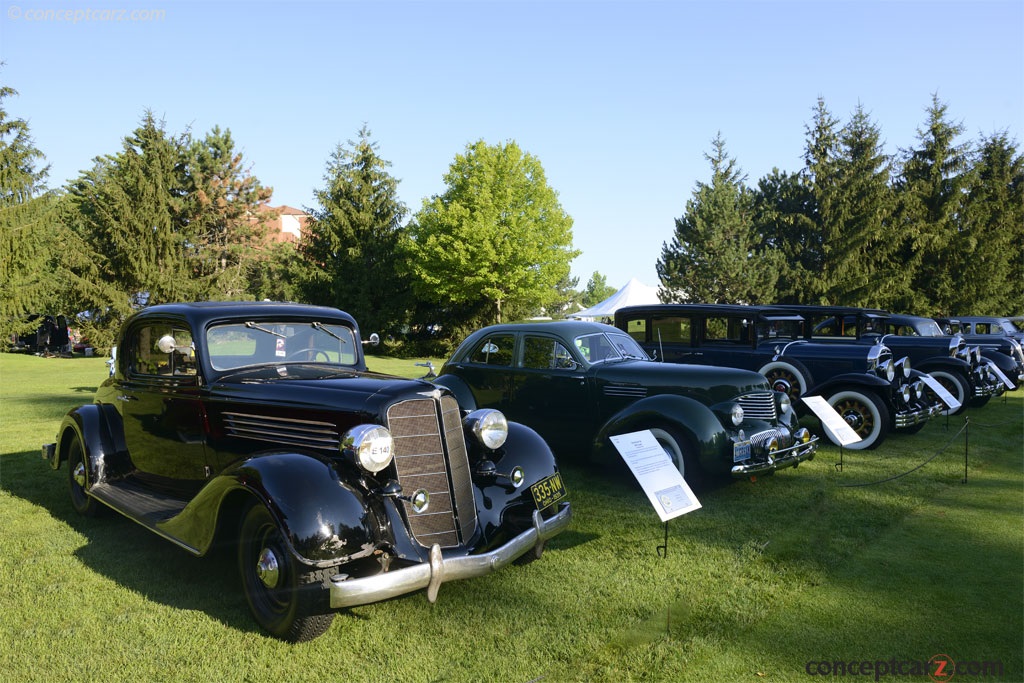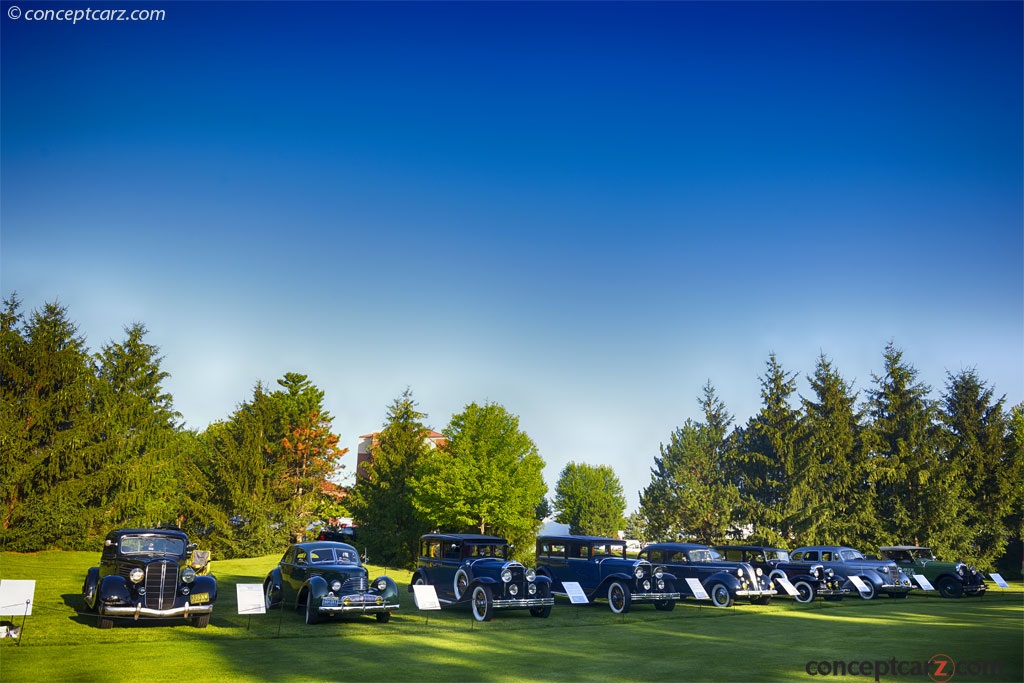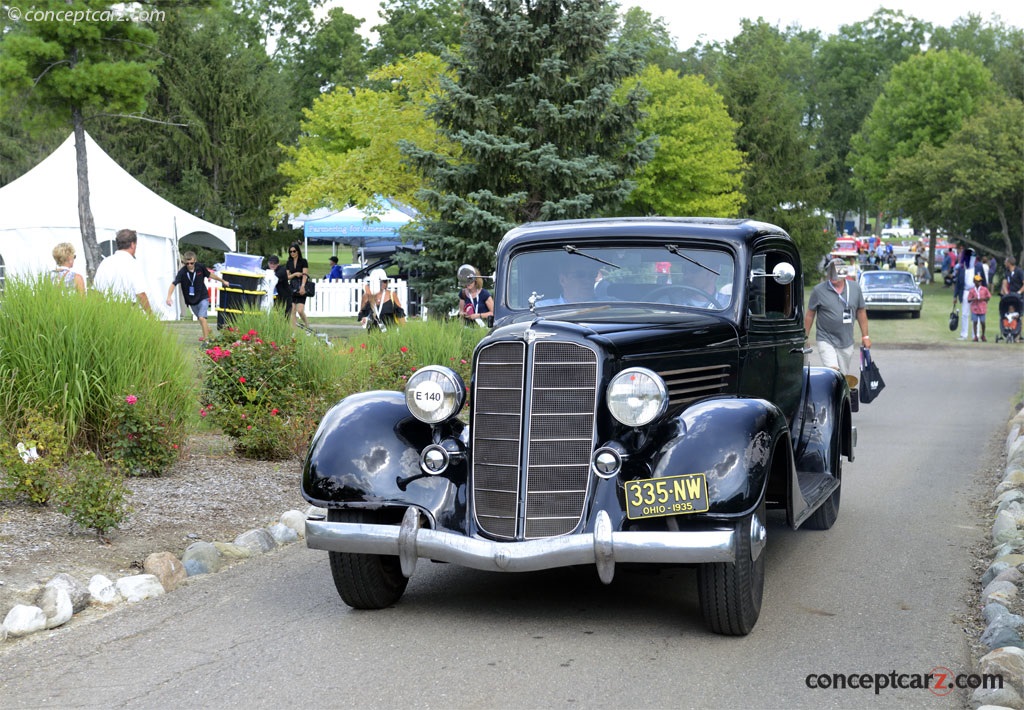Buick's line of two- and four-cylinder models were joined by a six-cylinder model, the Model B-55, for 1914. It had a single block casting, overhead valves, four-main bearings, mechanical valve lifters, a Marvel carburetor, a 331 cubic-inch displacement, and delivered 48 (SAE) horsepower. The engine was backed by a sliding gear, three-speed manual transmission with mechanical brakes on two wheels. By 1916, the entire Buick lineup was powered by six-cylinder engines - the 331 CID inline-6 and a 224 CID six with approximately 45 hp. 
Sport Coupe
View info and historyDue to a shortage of materials, Buick models reverted back to four-cylinder power for 1917, and the 225 CID six was dropped in 1918 and replaced by a 242 CID six. By 1919, Buicks were solely powered by six-cylinder power, joined in 1922 by a four-cylinder model. Buick adopted new series designations in 1925, with the Standard Six powered by a 191 CID inline-6 and resting on a 114.3-inch platform while the Master Six was powered by a 255 CID inline-6 and built atop a 120- and 128-inch wheelbase. The 1929 models were the first Buicks to receive styling by General Motors Art and Colour department. The three series were known as the Series 116, Series 121, and Series 129 - representing wheelbase measurements. The Series 116 used a 239.1 CID inline-6 while the Series 121 and 129 were powered by a 309.6 CID inline 6.
Sport Coupe
View info and historyAnother naming scheme was applied to the 1930 Buicks, with the Series 40 (118-inch wheelbase) representing the entry-level vehicles, the intermediate level Series 50 (124-inch wheelbase) replacing the previous 121, and the top-of-the-line Series 60 on a 132-inch wheelbase. The 257.5 CID six in the Series 40 developed 80 hp, and the Series 50 and Series 60 were powered by a 331.4 CID six with 99 hp. Eight-Cylinder Engines
The 1931 Buick lineup included the Series 50, Series 60, Series 80, and the Series 90 - all with eight-cylinder power, with the 220.7 CID unit in the Series 50 delivering 77 hp, the Series 60 using a 272.6 CID inline-8 rated at 90 hp, and the Series 80 and 90 fitted with a 344.8 CID inline-8 with 104 hp. They all employed a sliding gear, synchromesh three-speed transmission with a single dry plate clutch for the Series 50 and 60, while the Series 80 and 90 received a double dry plate clutch. Mechanical brakes on all four wheels provided the stopping power. The Series 50 had a 114-inch wheelbase, the Series 60 a 118-inch platform, the Series 80 measuring 124-inches, and the Series 90 at 132-inches. All Buicks were lowered by 2.25-inches for 1933 and received twin taillights, a new X-cross member frame, and Fisher No-Draft ventilation. The free-wheeling system now allowed the driver to switch between freewheeling and direct drive as needed. The synchromesh transmission received helical gears for 1934 which allowed for shorter shift lever movement. The Series 40 joined the lineup and the Series 80 was dropped.
Sport Coupe
View info and historyThe 1935 Buick line consisted of the Series 40 on a 117-inch wheelbase, the 119-inch wheelbase Series 50, the 128-inch w.b. Series 60, and the range-topping Series 90 on a 136-inch platform. The Series 40 was priced from $795 to $925 and the Series 60 listed for $1,375 to $1,675. Between them was the Series 50, offered as a sport coupe, business coupe, convertible coupe, victoria coupe, and a sedan. Prices ranged from $1,110 to $1,230 with the convertible coupe being the most expensive. The most popular was the sedan, priced at $1,190 and 3,778 examples built. Next in regards to popularity was the Victoria Coupe with 1,589 examples built, followed by 268 of the sport coupe, 257 of the business coupe, and 170 of the convertible coupe. The combined 6,062 examples of the Buick Series 50 built in 1935 accounted for approximately twelve-percent of Buick's total production.The 235 cubic-inch inline-8 had overhead valves, a cast-iron block, five main bearings, mechanical valve lifters, a Marver carburetor, and delivered 88 horsepower. It was backed by a three-speed sliding gear, synchromesh transmission, and stopping power was by mechanical brakes on four wheels. 
Sport Coupe
View info and historyThe Series 50 was similar to its 1934 sibling, with the only change being the addition of a center rear armrest on closed models. Wide walnut grained metal window interior trim was used on closed bodies, and safety glass was used for the vent windows and windshield. Narrow horizontal louvers could be found on the hood.The Series 50 was dropped after 1935 and brought back in 1940 wearing the 'Buick Super' designation. They shared the same 121-inch wheelbase as the Series 40 'Special', along with the same 248 CID inline 8, and offered in a range of five body styles, all without running boards. Production of the Buick Super would continue through 1958, with production paused during World War II. It was replaced in 1959 by the Buick Electra.
by Daniel Vaughan | Feb 2021

Sport Coupe
View info and history

Sport Coupe
View info and history
The 1931 Buick lineup included the Series 50, Series 60, Series 80, and the Series 90 - all with eight-cylinder power, with the 220.7 CID unit in the Series 50 delivering 77 hp, the Series 60 using a 272.6 CID inline-8 rated at 90 hp, and the Series 80 and 90 fitted with a 344.8 CID inline-8 with 104 hp. They all employed a sliding gear, synchromesh three-speed transmission with a single dry plate clutch for the Series 50 and 60, while the Series 80 and 90 received a double dry plate clutch. Mechanical brakes on all four wheels provided the stopping power. The Series 50 had a 114-inch wheelbase, the Series 60 a 118-inch platform, the Series 80 measuring 124-inches, and the Series 90 at 132-inches. All Buicks were lowered by 2.25-inches for 1933 and received twin taillights, a new X-cross member frame, and Fisher No-Draft ventilation. The free-wheeling system now allowed the driver to switch between freewheeling and direct drive as needed. The synchromesh transmission received helical gears for 1934 which allowed for shorter shift lever movement. The Series 40 joined the lineup and the Series 80 was dropped.

Sport Coupe
View info and history

Sport Coupe
View info and history
by Daniel Vaughan | Feb 2021
Related Reading : Buick Series 50 History
In 1903, the Buick Motor Car Company was formed by David Dunbar Buick. In 1907, over 725 vehicles were produced, and one year later, it grew drastically to over 8,800 with the help of the ever-popular Model 10. By 1940, Buick had moved into the higher end and larger car range. Even though over 16,500,000 cars use the Buick name, Mr. Buick was only involved with 120 of them. In 1929, he passed away....
Continue Reading >>
Continue Reading >>
Related Reading : Buick Series 50 History
Buicks best-selling vehicle of 1930, the Series 40 was the precursor to the Series 50. With a wheelbase that stretched to 124 inches, the Series 121 was renamed the Series 50. The large six engine was enlarged to 331.5 cubic inches and achieved 98 hp and 2,800 rpm. The Series 50 ranged in price from %241,510 to %241,540. The styling of the Series 50 was new and featured conservatively sporty lines and....
Continue Reading >>
Continue Reading >>
Similarly Priced Vehicles
Buick Monthly Sales Volume
March 2023
38,138
1935 Buick Series 50 Vehicle Profiles
Recent Vehicle Additions
Performance and Specification Comparison
Price Comparison
$795 - $925
$1,460
$1,875 - $2,175
Series 50 Specification Comparison by Year
Year
Production
Wheelbase
Engine
Prices
Related Automotive News

The Don Williams Collection of Stunning Pre-War Classics, Including 1937 Mercedes-Benz 540K, Will be Offered with No Reserve During Barrett-Jackson's 2024 Scottsdale Auction
Barrett-Jackson, The Worlds Greatest Collector Car Auctions, will offer seven stunning classic vehicles from the Don Williams Collection during the 2024 Scottsdale Auction held January 20-28 at WestWorld of Scottsdale. Each premium vehicle...

Best in Show at The Greenbrier Concours d'Elegance
The fifth annual edition of The Greenbrier Concours dElegance at Americas Resort, The Greenbrier, attracted a curated list of nearly one-hundred exquisite vehicles to the luxury mountain resort located in the Allegheny Mountains in White Sulphur...

Gooding & Company Looks Toward Pebble Beach with Stunning Selection of Historic Prewar Classics
Highlights include a top-of-the-line 1930 Duesenberg Model J Disappearing-Top Convertible Coupe, a Grand Prix-winning 1929 Bugatti Type 35B, a well-documented 1914 Stutz 4E Bearcat, and an opulent 1910 Rolls-Royce 4050 HP Silver Ghost Pullman Limousine.
As...
MERCEDES-BENZ 2014 G63 AMG: THE ULTIMATE G-CLASS
The latest technology for the AMG off-road icon the new 2014 G63 AMG impresses with a state-of-the-art powertrain, expressive new design and improved efficiency. All this is largely attributable to the AMG 5.5-liter V8 biturbo engine delivering 536...

Edsel Ford's Speedster Stars at 'The Amelia'
Edsel Fords continental car, a custom boattail speedster, will take its rightful place in the Sports Car Class of the 18th annual Amelia Island Concours dElegance. In the shape of Edsels seminal speedster is the genesis of Fords legendary design...













